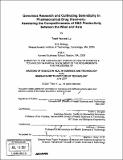Genomics research and cultivating serendipity in pharmaceutical drug discovery : assessing the competitiveness of R&D productivity between the West and Asia
Author(s)
Lu, Trent Yen-wei
DownloadFull printable version (6.778Mb)
Other Contributors
Harvard University--MIT Division of Health Sciences and Technology.
Advisor
Frank L. Douglas and Anthony J. Sinskey.
Terms of use
Metadata
Show full item recordAbstract
It has been widely reported that pharmaceutical drug discovery innovation began its major decline somewhere in the last decade of the 20th century. After reaching a historical high of 53 new molecular entities (NMEs) in 1996, the industry has since witnessed a steady decline of NME filings (down to 18 in 2006) with the Center for Drug Evaluation and Research (CDER)---despite rapidly escalating R&D spending among the world's major pharmaceutical firms (the "majors"). Industry leaders, researchers, and observers have all but acknowledged this drug discovery productivity crisis, much of it attributed to the industry's preference for and eventual exhaustion of simple, single molecular targets-the so-called "low-hanging fruit" whose discovery is characteristically attributed to serendipity. Collectively, pharmacological compounds were identified that targeted the products of -400-500 genes in the human body over the past five decades. These single-molecular targets-the majority of which are mechanistically overrepresented by the G-protein coupled receptors and key enzymes--are now believed to have been mostly discovered and commercialized into the ubiquitous blockbuster drugs on the market, ranging from statins to proton-pump inhibitors (PPIs). (cont.) Historically and nearly coincident with this apparent dearth of new molecular targets was the advent of the 99% completed euchromatic sequence' of the human genome in 2004, as reported by the International Human Genome Sequencing Consortium (IHGSC). Launched in 1990, the Human Genome Project (HGP) thus made available thousands of the approximately 30,000-40,000 estimated human genes that could be potentially associated with disease. Given the therapeutic promise of the supposed -3,000 druggable genes2, the major pharmaceutical firms have allocated sizeable investment into genomics-based drug discovery. The realization of senior research executives that future drug innovation will likely be based on a multi-gene, systems biology-based model for understanding complex disease mechanisms of action has resulted in a shift away from reliance on serendipity toward a model informed by genomic elucidation of inter-pathway connectivity. In my research, I examined the level and type of genomics-related investments made by selected majors in the West (U.S., Europe) and Japan. Moreover, I have leveraged genomics as a "lens" to assess the nature and role of serendipity in drug discovery-which I have posited can be deconstructed into the two different facets of technological capability and organizational design. (cont.) Thirdly, the impact of personal-, firm-, and country-level ethnic & national identity, cultural & historical legacy, and social factors on productivity are investigated. Through the use of personal interviews with senior pharmaceutical industry research executives, an online survey questionnaire completed by research managers and staff, and publicly available information, it was found that the Western and Japanese majors shared major similarities surrounding the original impetus to invest in genomics. While Western firms were found to reap significant benefits from superior scale and decisively 'permeated' genomics as the central platform technology throughout their drug discovery organizations, Japanese firms were found to exhibit greater efficiency in resource utilization in genomics-based discovery. Furthermore, the finding of 3 distinctive national culture characterizations for Western, Japanese, and Chinese firms revealed differential influences on their respective firms' drug discovery practices and productivity. Finally, the state of China's genomics and life sciences firms was evaluated. Prescriptive recommendations for the development of the nascent pharmaceutical industry in China, based on conclusions drawn above, are provided.
Description
Thesis (S.M.)--Harvard-MIT Division of Health Sciences and Technology, 2007. Includes bibliographical references (leaves 56-61).
Date issued
2007Department
Harvard University--MIT Division of Health Sciences and TechnologyPublisher
Massachusetts Institute of Technology
Keywords
Harvard University--MIT Division of Health Sciences and Technology.